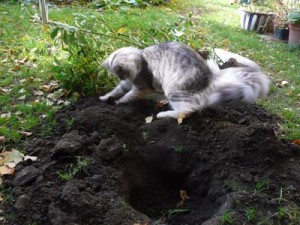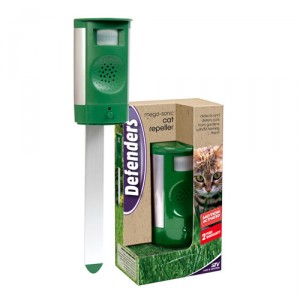How To Keep Cats Away
November 8, 2012 by admin
Filed under Gardening, Pest Control, Pets
I am often asked how to keep cats away from yards. Cats are unpredictable, so there are few sure-fire cat repellents. But below I consider some of the best approaches known to keep cats away from yards. Broadly speaking, we can label all of these diverse approaches as “cat repellents,” since they are all designed to repel unwanted feline intruders from a specific area. But I’ll also provide an example of the commercial products more narrowly associated with the label, “cat repellents,” namely, products that come in a can and are sprinkled on the ground to keep cats away.
A Cat Repellent Before You Even Begin
If you haven’t planted a flower bed yet, but you anticipate having trouble keeping cats out of your yard, be aware that one of the most effective cat repellents is readily available at most any hardware store: chicken wire.
No, I’m not going to suggest you erect a chicken-wire fence. Instead, lay chicken wire down on top of your soil (or mulch, if you’re using mulch in the bed), across the planting bed, before you plant. Why? Because cats disdain walking on chicken wire. Using wire cutters, you’ll be able to open up pockets in the chicken wire sufficiently large for installing your plants.
Cat Repellents After the Fact: 10 Ways to Keep Cats Away From Yards
But what if it’s too late for the chicken-wire option? Not to worry. The ten cat repellents on which I focus below are all intended for existing garden beds. While on the subject of wire, I’ll begin with electric wire fences.
1. Like rabbits, cats can be kept away humanely with the Mr. McGregor Fence. This fence is so safe that even Responsible Consumer.Net recommends it.
Water: The Ultimate Cat Repellent?
Sometimes, to keep cats away from a yard, you have to think like a cat. Put yourself in the cat’s place. Observe cat behaviour. For instance, they’re pretty fussy creatures, aren’t they?
One of the things cats are fussy about is getting wet. Water is “kryptonite for cats.” Getting wet seems to be almost a phobia for them. Use that phobia to your advantage in trying to keep cats away from yards.
2. When you catch cats in the forbidden area, you can try hosing them down with a Super Soaker or similar water gun. Such action may reinforce the notion that they are unwanted in your planting bed.
3. But if that doesn’t work, you can go hi-tech. Devices such as Scarecrow Sprinklers detect an intruder’s presence and fire a blast of water at it.
Thinking like a cat again, another thing we can say cats are fussy about is how something smells. You can use feline fastidiousness to keep cats away from your yard in a number of ways:
Commercial Cat Repellents
4. One of the commercial cat repellents available is a powder called, “Shake-Away.” Shake-Away bears the scent of the urine of predators that cats fear, namely, the coyote, the fox and the bobcat. This commercial cat repellent comes in a granular form, which you simply sprinkle around the problem area. The product is advertised as being organic, making it an acceptable option to use around children and pets. Nor will it harm your plants.
Plants That Are Cat Repellents
5. Some plants give off smells that cats dislike. One such plant, Coleus canina, goes by the common name, “scaredy cat plant.” As the second term in the Latin name indicates (think “canine”), it is also effective if you have trouble landscaping with dogs. Other plants often recommended for keeping cats away from yards are:
• rue,
• lavender, which deer pests also dislike
• pennyroyal
Other Substances That Double as Cat Repellents
6. Try sprinkling “stinky” substances around the problem area, including:
• dried-blood (“blood meal”) fertilizer
• mothballs (drop them into a can or jar, cover, and make a few holes in the cover)
• cayenne pepper flakes (but see below)
Note that mothballs are toxic, thus the recommendation that you use them in a covered can or jar. Avoid even this usage if small children will be in the yard and could, potentially, open such a can or jar. Note also that some people caution against using cayenne pepper in this fashion, saying it can be harmful to cats. So if you’re an animal lover or tend to be on the cautious side, then save the cayenne pepper to flavour your food!
http://landscaping.about.com/od/pestcontrol/a/cat_repellents.htm
Still “thinking like a cat” to figure out how to keep cats out of gardens, let’s consider something else cats are fussy about: the texture of what they step on. After all, it’s not for nothing we have the expression, “pussyfooting around.” I already mentioned chicken wire in this context.
How to Keep Cats Out of Your Garden: No “Pussyfooting Around”
7. Cats don’t like to walk on bristly material. So in mulching the problem bed, include something on which the refined paws of cats will fear to tread, such as sharp-edged pine cones.
8. Another mulch-related idea is to use stone mulch. It may not be the most attractive mulch for your particular bed, but cats prefer to poop in loose dirt. Cats usually won’t bother with an area mulched in stone. They’d rather be “pussyfooting around” where the digging’s easier on their paws.
How to Keep Cats Out of Your Garden: Striking a Compromise
As in landscaping with dogs, sometimes the path of least resistance provides the best solution to your problem. Strike a compromise with your cat by planting a separate bed of catnip plants, in another part of the yard. Not all cats go nuts over catnip plants, but those who do may come to view their “catnip patch” as their own private sanctuary.
9. Better still, make a sandbox just for cats and keep it in close proximity to the catnip plants. Chances are that the sandbox will serve as a magnet for cat poop. Sure, you’ll have to clean up the cat poop afterwards. But at least you’ll know where it is.
How to Keep Cats Out of Your Garden: Hi-Tech to the Rescue, Again
Hi-tech approaches to keeping cats out of gardens don’t stop with the motion-activated sprinklers mentioned. You can also keep cats out of gardens using ultrasound.
10. Simple to install, this sonic cat scarer can be set up within seconds. Effective in all weather conditions, it also provides 50% more coverage than other cat repellers on the market. One unit can protect a garden of up to 40 feet in length. For larger gardens the repeller can be used solely to target problem areas or in multiples to cover the entire area. The ultrasonic frequency emitted is inaudible to humans, so will not hinder your enjoyment of your outdoor areas.

